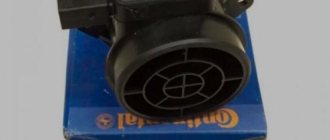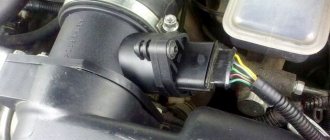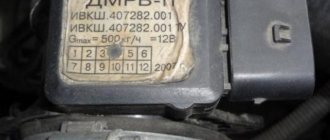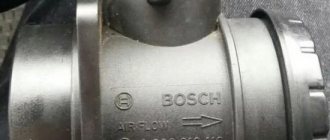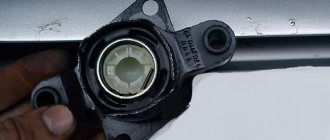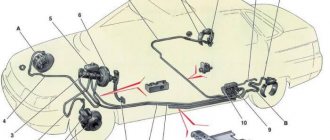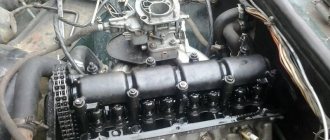DMRV VAZ 2110 (mass air flow sensor) is an electronic device of a VAZ car, with the help of which the amount of air entering the cylinders is calculated. The MAF 2110 transmits the measurement data to the vehicle's electronic control unit, which, based on this information, determines the air-fuel ratio in the air-fuel mixture using a pulse signal.
It is not difficult to guess that the VAZ 2110 air sensor, which is responsible for the composition of the air-fuel mixture, is an important element; the fuel consumption and power of the internal combustion engine depend on the efficiency of its operation. For this reason, it is very important to monitor the condition of the sensor and correctly diagnose the malfunction. Next, we will look at what are the signs of a malfunction of the mass air flow sensor, as well as how to check and how to replace the mass air flow sensor on a VAZ 2110.
Principle of operation
The piston stroke occurs when fuel is burned with air in a ratio of 1:14, maintaining which ensures optimal operation of the power plant. When the proportion decreases or increases, the engine does not stop working, but there is excessive fuel consumption or a decrease in engine operating power. We need a mass air flow sensor so that air flows in portions. The operation of the unit proceeds as follows: the VAZ 2110 air flow sensor calculates the portion of fresh air, and then sends the data to the main computer, which, based on this information, calculates the portion of fuel.
The harder you push the gas, the more filtered air the powerplant requires. The mass flow sensor detects the increase and commands the electronics to increase the amount of fuel. When moving at the same speed, each portion should be equal to the previous one. The mass air flow sensor receives data on the load of the power unit, and then calculates the required portion of air. When the driver presses the pedal, the throttle valve opens, thereby increasing the volume of intake air - the load increases. When the pedal is released, the load drops.
Damaged sensor due to dust
Information about the operation and design of the mass air flow sensor
Again, we will not consider the historically outdated mechanical options with a weather vane and the General Motors frequency flow meter, which was used in conjunction with the January 4-series ECU. Modern flow meters for the VAZ 10 series operate on the principle of a hot-wire anemometer.
It is based on the properties of some metals to significantly change resistance depending on heat (the MAF sensor uses an alloy of iridium with platinum, which causes the high cost of the device). There are two resistors in the air flow: one is precision, the second can change the resistance using heat. Voltage is applied to it, the thread is heated until it matches the standard. Depending on the strength of the air flow, the thread cools and the resistance changes. By increasing the voltage across the resistor, the temperature and, accordingly, the resistance are restored. This happens in real time, that is, the control of the air mass is constant. At the output, the mass air flow sensor displays the signal voltage with an accuracy of hundredths of a volt. The received information is processed by the ECU to accurately dose gasoline into the fuel-air mixture.
What happens if the flow meter breaks down? The engine will continue to operate, but in emergency mode. At idle speed without load, the speed will be set to 1500, power will be lost, and fuel consumption will increase. In some modes the motor may stall.
All elements are arranged into a single electronic model, which is placed in the measuring channel (air duct).
Sensor device
The sensor itself is a combination of two sensors - control and working, as well as a heating resistor.
View of the flow meter from the grid side.
The sensor is disassembled.
The platinum thread is visible in this photo.
As a result, air flow and temperature are converted into electrical impulses understandable to the ECU. This is a very gentle and accurate device; it allows you to calculate the cyclic filling of the cylinders with air and updates the parameters every 0.1 s.
Mass air flow sensor diagram.
The working body of the sensor is a heated platinum thread. It heats up to operating temperature (from 100 to 1000 degrees), and when air enters, it cools down. The amount by which the filament temperature drops is converted into an electrical signal and, based on this value, the ECU calculates the mass and temperature of the air entering the combustion chamber. And based on this data, it prepares the required portion of fuel. In short - yes.
Visual inspection
As for visual diagnostics, first of all it is necessary to check the condition of the corrugation in which the flow meter is installed, as well as the device itself. If, as a result of the check, you see traces of motor fluid or condensation, then it is possible that the device does not work for this reason. In some cases, cleaning the device from contaminants allows the flowmeter to resume operation and prevent possible replacement. It should be taken into account that contaminants usually accumulate as a result of infrequent replacement of the air filter element (the author of the video about the regulator malfunction is the channel In Sandro’s Garage).
If you notice traces of engine fluid, then there is a possibility that the reason lies in a clogged oil seal, or the problem may lie in exceeding the permissible level of lubricant in the crankcase. When cleaning is complete, you will need to make a visual inspection of the regulator - on the front of it you can see the rubber seal that is used for sealing. The seal is necessary to prevent uncleaned air flow and it may be that the rubber band moves a little - this will lead to the accumulation of dust on the flowmeter grid.
Verification methods
There are several ways to check the mass air flow sensor with your own hands.
Shutdown
One way to check the flow meter is to turn it off. To do this, you need to remove the connector that connects the mass air flow sensor to the VAZ 2110 system.
Disconnecting the connector from the device
In this case, emergency mode is activated, the amount of air required is calculated based on the throttle position. If the car moves more dynamically with the sensor disabled, it needs to be replaced or repaired; perhaps cleaning will help.
Checking with a multimeter
To check, you need a multimeter and knowledge of repairs and how to handle the tester. The measuring device must be set to constant pressure measurement mode, designated by the letter V or DCV.
Multimeter for testing
To understand the operation of the mass air flow sensor, you need to know its pinout:
- a pink or red-black wire leads to the central unit;
- green wire – grounding;
- The white-gray wire is intended for voltage output;
- The yellow wire is used to supply current to the signal input.
Prevention and testing of mass air flow sensor on VAZ 2110
As a preventive measure, we can recommend timely replacement of the air filter. The use of sports zeros shortens the life of the flow meter. In any case, regular cleaning of the air flow sensor will not hurt.
- We disconnect the sensor connector, having first removed the ground from the battery.
- Carefully unscrew the flow meter housing from the intake manifold flange.
- If dust deposits are detected, blow out the cavities with compressed air.
- Of course, you also need to clean the air duct and air filter box at the same time.
Tip: It is recommended to repeat this operation every time you replace the air filter.
If the contamination is severe (with oil and moisture), you can use a special Liqui Moly Luftmassensensor-Reiniger cleaner, which was created specifically for cleaning the mass air flow sensor. To do this, it is necessary to direct the jet not only to visible sensors, but also to hidden cavities where the platinum resistor (thread) is located.
After this, the flow meter is installed in its regular place and the functionality of the electronic part is checked.
Cleaning
Quite often you can avoid replacing the mass air flow sensor by simply cleaning this engine element.
You should do the cleaning yourself in this way:
- Remove the pipe from the mass air flow sensor;
- Now remove the sensor from the pipe. Otherwise, high-quality washing will not work;
- To remove the sensor, arm yourself with sprocket keys in advance. Finding such kits is not a problem;
- Unscrew all the fasteners, remove the sensor from the pipe and assess its external condition;
- Often there are traces of oil deposits on the sensor. The purpose of cleaning is to make the device as good as new;
- Carburetor cleaner is often used to clean the air flow sensor;
- Inside the film there are sensors, which are small wires attached to a special resin. These elements must be carefully sprayed with cleaner so as not to damage the devices;
- Wait a while for the surfaces to dry. To speed up the process, use a can of compressed air;
- It is not uncommon to use alcohol instead of carburetor cleaner, which also works quite effectively;
- Proper cleaning of the mass air flow sensor involves treating the pipes from accumulated debris, dirt and dust;
- Having carefully processed all the components of the removed mass air flow sensor, wait until it dries, and then reassemble it. Cleaning is complete.
Spray cleaning
Statistics show that in about 80% of cases, simple cleaning can return the mass air flow sensor to its previous functionality.
Additional manipulations
It is now clear how to clean the mass air flow sensor, but this procedure alone does not end everything; it is necessary to perform a number of additional and necessary manipulations. And you need to do this before installing a clean device. And while the cleaning agent is drying, it’s time to work on the air pipe. It is worth carefully inspecting it for integrity. And if the condition is unsatisfactory - there are cracks and other damage, then it should be replaced.
As experts note, before installing the mass air flow sensor, it is advisable to replace the filter element. You should also check the condition of the rubber seal. Here it is important to pay attention to how tightly it fits, otherwise it will not be possible to avoid the suction of outside air, which is flooded with various contaminants. As a result, cleaning will be required again, and in a fairly short time. Or it will lead to its failure altogether.
Let's sum it up
As you can see, the VAZ 2110 mass air flow sensor is a fairly important component of the car in the ECM device. This sensor closely interacts with the computer and determines the degree of enrichment of the fuel mixture with air.
It is quite obvious that any malfunction of the sensor will sharply reduce the efficiency of the engine. At the same time, selecting and replacing the sensor is not difficult. The main thing is to choose the right device and follow the instructions above.
We also recommend reading the article on how to replace the cabin filter on a Lada Granta. From this article you will learn when to change the cabin filter on a Grant, as well as how to change the cabin filter on a Grant with your own hands.
Finally, we note that if the sensor is dirty, it is not necessary to immediately resort to replacement. At the initial stage, it is cleaned, as well as the pipes are treated to remove accumulated debris, dust and dirt, and at the same time, all components of the sensor are inspected. However, if there is no positive result, it is necessary to purchase and replace the device.
Types of mass air flow sensors
We will consider a sensor that makes it possible to determine the volume of incoming air using the example of the VAZ 2110. In the VAZ-2110, as in other cars, the device is located inside the air pipe, near the filter, and is responsible for recording the air flow coming out of the filter.
Mass air flow sensors are constantly being improved; today there are several meters that calculate consumed air:
- The main component is a pitot tube. The plate fixed in the sensor changes position under the influence of air flow. The inclination angle of the plate is measured by a potentiometer, which in turn changes the resistance. This serves as a signal for the control unit to determine the volume of incoming air.
- The mass production of modern mass air flow sensor devices requires the presence of hot-wire measuring mechanisms in the sensors. The heat exchanger contains 2 thin plates made of platinum. After energy is supplied to the plates to warm them up, one of them remains working, and the second - control. The MAF sensor in this design makes it possible to ensure a constant, identical temperature touching the 2 plates.
- The working elements of the film meter are silicon wafers coated with platinum.
Idle speed control
Signs and symptoms of a malfunctioning mass air flow sensor: self-diagnosis, cleaning and replacement of the air flow sensor
Today, in urban environments, drivers simply cannot do without idling. Therefore, every car, including the VAZ 2110, is equipped with an idle speed sensor. Incorrect operation or failure of this regulator will significantly complicate driving, because it will cause the engine to stop even during the shortest stops. So if the controller fails, and this is not uncommon in VAZ 2110 cars, it needs to be changed as quickly as possible.
Removing the idle air control
The main purpose of this type of regulator is to support the speed required for normal operation of the power unit. Thanks to the device, the driver can always make a short stop as a result of changing the incoming air volume. As for the location, this controller is installed on the throttle line. In particular, we are talking about an anchor stepper motor, which is equipped with two windings.
When a corresponding signal is received on one of the windings, a special needle moves forward one step and backwards one step. Thanks to the worm gear, the device rotates, which is produced using a stepper motor, thus converting this movement into translational. The rod itself, namely its conical part, is located in the line through which the air flow is supplied.
Thanks to the functioning of the rod, the system adjusts the idle speed of the power unit. The rod from the device, as mentioned above, can be retracted or extended. In this case, it all depends on what kind of pulse will be supplied from the regulator. The controller itself allows you to adjust the frequency at which the engine crankshaft will rotate when the machine is stopped for a short time.
In addition, the controller controls the incoming air flow, which bypasses the throttle in the closed position. When the engine is warmed up, the regulator, by controlling the movement of the rod itself, at idle speed allows you to maintain the required crankshaft speed. In this case, the load and condition of the power unit do not play a role.
Signs of malfunction of the DMVR
Mass air flow sensor design
Signs of a malfunctioning mass air flow sensor can be direct or indirect . Let's consider all possible options:
- Check Engine light on the dashboard. In most cases, the CHECK indicator lights up due to the failure of one of the sensors, so you need to connect to the ECU to accurately determine the fault.
- A drop in power is only an indirect sign, since there may be another reason for this malfunction.
- Increased fuel consumption . Of course, everything can be attributed to the fuel pump, but the fuel pressure sensor must also be checked. About standard fuel consumption indicators here.
- Reduced acceleration dynamics . An incorrect amount of air mixture that enters the combustion chambers produces a poor ignition mixture, which in turn does not allow the car to accelerate normally and leads to jerking when the gas pedal is sharply pressed.
- Poor start-up or inability to start . A rich or lean fuel mixture cannot detonate normally, which will lead to just such problems. It is also possible that fuel will not burn through and there will be popping noises in the muffler.
- Floating idle speed. Different amounts of air entering the fuel mixture will have an effect when the speed will either decrease or increase.
To accurately determine the malfunction of the DMVR sensor, it is necessary to diagnose it.
How to check the status of the mass air flow sensor in a VAZ-2110
In order for checking the mass air flow sensor in the VAZ-2110 to show the correct result, experts recommend using one of the following methods:
- First, you should disconnect the device connector and start the VAZ-2110 engine. After the sensor is disconnected, the controller begins to operate in emergency format and, based on the position of the throttle valve, prepares the fuel mass. As for the engine speed when checking the condition of the mass air flow sensor in the VAZ-2110, their number should not exceed the established 1500 revolutions per minute. Now get behind the wheel of a car and try to drive. If it seems that the car has begun to drive faster, it means that your assumptions have been confirmed - the mass air flow sensor is indeed faulty.
- If the standard firmware was previously replaced with some other one, it is extremely difficult to understand what is in it during an emergency operation. In this case, slide a plate whose thickness is close to 1 mm under the damper stop. The revs will immediately increase. Now remove the chip from the sensor. If the engine continues to run, it’s all a matter of the sensor’s firmware, or, to be even more precise, in the IAC steps in the emergency version without a mass air flow sensor.
- External inspection includes unscrewing the air intake corrugation clamp at the outlet of the mechanism. Pull it off and inspect the internal structure of the sensor and corrugation. Ideally, they should be dry and clean; the presence of condensation and oil solution are unacceptable signs.
If the air filter is not replaced regularly, the sensitive component of the sensor often fails, so make sure that the part is installed in a timely manner. As for the oil, there may be too much of it in the engine crankcase or the oil separator built into the ventilation is clogged.
The first method is to disable the sensor
This verification method is the simplest. Every car owner can do it. The first step is to turn off the sensor. To do this, you just need to unplug the connector. Then you should start the engine. As a result, the ECU controller will go into emergency mode. And the supply of the fuel mixture will be regulated only using the throttle valve. Idle speed will be around 1500 rpm. After this, you need to check in by car. If the car has improved its dynamic acceleration characteristics, then it makes sense to look for signs of a malfunction of the mass air flow sensor.
Checking with a multimeter
This test requires that you have skills in using a multimeter (tester). The method is suitable for almost all VAZ models, including 2110. We need to take a multimeter and set it to a mode that measures constant voltage, which is usually designated DCV or only V. To work with the mass air flow sensor, you need to understand its pinout, it is as follows:
- Yellow, closest to the windshield, supplies current to the signal input;
- Green indicates ground;
- The pink or red-black wire comes from the main relay;
- The white-gray wire is responsible for the voltage output.
The location of the wires and their sequence.
Depending on the model, the colors may be different, but the location does not change. Here you will have to deal with a specific model. But once you find the input signal wiring (closer to the windshield) and grounding, you can do it without instructions. The wiring is clear, now you need to turn on the ignition without starting the engine. The tester sets a limit of 2 Volts. The black probe of the tester is connected to the green ground wire of the air flow sensor, and the red one is connected to the yellow one. The measurement takes place between two terminals. The probes must be inserted carefully; an additional needle is not required, since the probes can be freely inserted along the wires without damaging the insulation.
We look at the tester display. If the consumable is new, then there we will see a voltage indicator of 1.01. Over time, the indicator increases as the resistors wear out (the resistance drops). The larger the number, the greater the wear of the sensitive element:
- In good condition, the indicator will be 1.01… 1.02;
- With “normal” - 1.02... 1.03;
- The sensor will soon stop working – 1.03… 1.04;
- The dying state of the flow meter is accompanied by an indicator of 1.04… 1.05;
- Replacement of the unit is required when the reading is 1.05 or higher.
Testing the mass flow sensor. The dipstick must be inserted carefully.
Diagnostics can also be carried out without a multimeter. Instead, you can use the on-board computer. To do this, you need to go to the “voltage from the mass flow sensor” section; we are interested in the “U MAF” indicator.
External signs of a malfunction of the VAZ 2110 mass air flow sensor
This is the third way to diagnose the sensor. To determine its serviceability, carefully inspect the internal cavities of the air pipe where the mass air flow sensor is mounted. In order to do this, you will need a shaped screwdriver. Loosen the clamp and disconnect the corrugated pipe. The surface of the corrugation should be as dry as possible, without an oil film.
It should be noted that the main signs of a malfunction of the mass air flow sensor are dirt on the working surface. It is formed due to the fact that the air filter was not replaced in time. Oil deposits will tell the driver that the oil level in the lubrication system is high or that the oil cutter is not working properly. With these signs, the sensor may still work, but will soon fail.
Next you need to completely remove the mass air flow sensor. You will find signs of a malfunction after a visual inspection of the device. To carry out this operation, you will need a 10mm wrench. Unscrew the two screws and remove the device from the air filter housing. A rubber seal will come out with the sensor. If the seal remains in the housing, this is the main sign of imminent failure.
Checking with a scanner
Test method:
- Install a diagnostic program on your phone (smartphone), tablet or laptop computer (for example, Torque Pro, Opendiag, BMWhat, OBD Auto Doctor).
- Connect your mobile device or laptop to the diagnostic connector located on the vehicle's electronic control unit using a special cable, Bluetooth channel.
- Launch the diagnostic utility on your phone (smartphone) or computer.
- Wait until the program finishes scanning all vehicle components. As a result, the utility will check the serviceability of each vehicle unit.
- Decipher the error codes that the program will show after the diagnostics are completed.
To perform this method, testers are used:
- K-Line 409/1;
- Scanmatic;
- ELM (ELM) 327;
- OP-COM.
Using a motor tester
GOOD TO KNOW
This method is used to test frequency-type flowmeters.
To check the mass air flow sensor with a motor tester (oscilloscope), you need to connect it to the sensor (depending on the car brand) and start the engine.
Mass air flow sensor check parameters:
- transient time when the ignition is on;
- air consumption readings at idle and a sharp increase in engine speed;
- voltage in the sensor network.
IT IS IMPORTANT TO KNOW
The output data is individual for different types of engines. Before diagnosis, you should check the current indications with an official representative.
Main symptoms
So. If you have problems with your mass air flow sensor, the signs of a malfunction can be very different. Among them are failures during acceleration, lack of traction, and decreased power. There is a persistent feeling that the car simply “does not go.” If there is no proper response when you press the gas, then this is one of the signs. High fuel consumption is also a signal for diagnosing this sensor. When your car stalls when shifting from gear to gear, it makes sense to check the MAF sensor. The VAZ 2110 has the same symptoms of malfunction as other cars.
If you have difficulty starting a cold engine, if the engine operation is unstable, if the speed spontaneously increases or, conversely, decreases, if detonation occurs under load - these are all signals for checking and diagnosing the sensor.
Diagnostics using a multimeter
Diagnostics can be performed using a multimeter; for this we recommend that you read the operating instructions for the tester. The device must be configured in the DC voltage measurement mode; it is usually marked with the symbols DCV or V.
To ensure that connecting the device does not cause difficulties, you need to know exactly the pinout of the device:
- black-red or pink contact is a connection to the control module;
- green is ground (grounding, ground), connected to the body or battery;
- gray-white contact - output voltage;
- yellow - used to supply current to the input.
Diagnostics with a multimeter is performed as follows:
- To begin with, the tester should be turned on and the voltage value set on it to 20 volts, and then the probes from the device are connected to the corresponding contacts on the plug.
- To make the connection more convenient, you can use pins; you will need two of them. Each of them is installed in a hole with green and yellow contacts. Then you will need to connect the probes of the device to these pins.
On a working device, the voltage level will be around 1.01-1.04. If the readings are between 1.02 and 1.05 volts, this indicates that the device will need to be changed in the near future. If the readings obtained are higher, then the flow meter must be replaced because it is faulty.
It should be noted that during operation, the voltage parameter will only increase, since the resistor components of the device wear out, and the resistance value, accordingly, decreases. You can also accurately determine the voltage using the on-board computer, if it has the appropriate function. To search, go to the flowmeter voltage section and find the U value.
Step-by-step instructions for DIY diagnostics
- Turn on the ignition, but do not start the engine.
- Switch the tester or multimeter to voltage measurement mode. Set the scale limit to 2 volts.
- Connect the probe with the red wire from the voltmeter to the sensor terminal (the yellow wire goes to it).
To make it easier to measure the output voltage, use a pin. Be careful not to damage the insulation - Connect the black probe to the “Ground” contact (black-green wire).
- We record the value of the voltmeter.
The serviceability of the sensor is judged by the voltage value. To help the driver, below is a small table:
| Range of values | Air flow sensor condition |
| 1,01 — 1,02 | good |
| 1,02 — 1,03 | satisfactory |
| 1,03 — 1,04 | resource is running out |
| 1,04 — 1,05 | "near-death" state |
| 1.05 and above | it's time to change |
Visual inspection
Here we need to carefully examine the surface of the corrugation and consumables. To check the condition, we need to loosen the air intake clamp at the outlet of the mass air flow sensor, and then pull it off. If you see traces of grease or condensation on the surface, then most likely they have damaged the unit. Sometimes the sensor can be “reanimated” by removing all the dirt. It ends up in the consumables due to rare changes of the air filter. If liquid appears on the sensitive element, this is a 90% failure. Lubricating oil enters due to a clogged oil separator or due to an increased level in the crankcase.
Drops of oil on the sensor are a sure sign that it has failed.
If the above-described elements are detected, the diagnosis can be completed. If the surface is clean, move on. Remove the consumable from the air filter. It is held in place only by 2 screws, which are unscrewed with the 10th key. Looking at the photo, we see that there is an o-ring on the front of the mass flow sensor. It is installed for sealing - unfiltered air cannot leak through the inlet.
If this ring (in the photo it is green, but your color may be different) has slipped or remains in the filter housing, then a layer of dust can be found on the consumable mesh. Such a defect is enough to cause the sensitive element to fail. You need to assemble the unit according to the following scheme: check the reliability of the sealing skirt, put on the rubber ring, place the sensor in the air filter housing.
Voltage readings of a working and faulty sensor
- 1.01-1.02 — readings from the new sensor, everything is normal.
- 1.02-1.03 — there is wear, but the parameters are within normal limits.
- 1.03-1.04— the parameters are working, but there is already wear.
- 1.04-1.05— critical parameters, get ready for replacement, if you have the money, then we’ll change it. Fuel consumption may be reduced.
- 1.05 and higher - the mass air flow sensor is not working.
Measurement using paper clips - there may be an error on the device. According to the readings, it is clear that the sensor “ordered to live long”
How to check
There are two main methods for checking the DMVR sensor:
- Start the engine and check its operation with the sensor turned off, that is, it must be turned off. In this case, the electronic unit will start the engine in emergency mode. It is also necessary to drive several kilometers with the sensor turned off, this will help assess the dynamics and power of the engine as a whole. If there are no malfunctions in the engine, then all symptoms will indicate a sensor malfunction.
- In the second case, a voltmeter is used, and here you only need to turn on the ignition in the car. And the voltmeter should immediately show a value of 2V. After this, connect the probe with a plus to the yellow wire of the sensor, and the black probe to the green wire. And then you should observe the data on the device. The sensor is operational and works correctly if the device displays data up to 1V. The indicators showed figures up to 1.03 V, then this is acceptable for now, if data up to 1.05 may indicate that the sensor will soon fail. If the readings are above 1.05, then the sensor needs to be changed.
Spare part selection
There are sensors on the market in three price categories:
- Inexpensive. Typically these are Chinese-made sensors priced up to 1,200 rubles.
- Average. This category includes sensors from AvtoVAZ and foreign analogues of approximately the same quality. Their price ranges from 1400 to 2600 rudders.
- Expensive. High-quality and reliable mass air flow sensors from manufacturers Bosch or Siemens. Their price can reach 5,000 rubles.
We recommend giving preference to original sensors from AvtoVAZ or foreign analogues in this price category.
Also, when choosing a sensor, pay attention to its catalog number. The number can be found on the case. We strongly recommend buying a sensor with the same number or selecting analogues based on it.
Peculiarities
We conclude that the sensor is selected not by the number of valves or engine size, but solely by the firmware version and ECU model.
Bosch sensor (21083-1130010-01) for controller January version 5.1.
For example, for the Bosch M7.9.7 ECU it is necessary to use the Bosch mass air flow sensor 0 280 212 116, and for the January controller version 5.1 - only Bosch 21083-1130010-01. That is, even if a sensor is installed from the factory that does not correspond to the ECU firmware, you cannot expect correct engine operation and normal fuel consumption. By the way, there are often cases when sensors were installed from the factory that do not correspond to the firmware version. Therefore, the first check is for compatibility. And then we take a multimeter and go into battle.
Replacement and installation instructions
After dismantling the old non-working sensor, before purchasing, you can ask a friend for a temporary air flow sensor from his car, and then check it in your 2110. If with another sensor the engine works without interruptions, the consumption does not increase, then it’s time to replace your flow meter. This is the simplest diagnosis that can be carried out when the first signs of a malfunction appear.
We have studied the malfunctions and symptoms, what a mass air flow sensor is is now clear. If we succeed in checking, and we know that the flow meter is faulty, all that remains is to replace it. To do this, you need to prepare a replacement unit (you can buy a non-standard model) and a screwdriver. Visual inspection implies analysis, but let’s repeat it again:
Shutdown
Pulling out the sensor is fairly easy. It is located in the air filter.
This method involves starting the motor with the sensor removed - we need to disconnect its connector. When turned off, the controller starts emergency mode, and new portions of the mixture are calculated based on the position of the damper. We need to drive a little, the speed should be above 1500 rpm. If the car behaves more dynamically without a mass air flow sensor, then the diagnosis is complete - it’s time to change the consumable.
Cleaning the sensor
Find out how and how to clean the VAZ 2114 mass air flow sensor: 3 best options
If you observe signs of a malfunction of the mass air flow sensor, then you can try cleaning the device.
By the way, this is the most expensive sensor of all in the line of front-wheel drive VAZ cars. But if yours is broken, don’t rush to change it. There is a small chance of restoring his “health”.
For the cleaning process you will need a special liquid that is used to clean the carburetor. Star keys are also useful. Unscrew the clamp, as well as the two “10” bolts.
Remove the pipe and take out the sensor. Spray the liquid onto the wire and tube. Work with extreme care, wait until this liquid has completely evaporated and leave the device to dry.
While the device is drying, remove the throttle assembly. You will see plaque inside the throttle assembly. It needs to be removed with liquid.
This dirt causes problems with the entire system. Because of it, problems with the mass air flow sensor appear, signs of a malfunction of the VAZ 2115, which bother beginners on automobile forums.
Do not remove the throttle cable. Place the knot on a cloth and treat particularly dirty areas with the liquid. Don't forget to clean the idle air control valve and the space underneath it.
After this, most likely, all signs of problems with the mass air flow sensor will go away, of course, provided that the sensor has no mechanical damage. Therefore, do not wait until you have the first signs of such problems, but take such prevention this coming weekend. It won't take you much time, and your car will truly breathe.
You won't recognize your engine. It will start much better, its traction will improve, and you will notice an increase in the power of your engine.
Carry out such preventive maintenance regularly, and your car will thank you.
The automotive market does not stand still; manufacturers are constantly improving car engine power, fuel consumption, aerodynamic values, and coming up with options for changing overall comfort. The main and obvious improvement was the transition from the use of a carburetor method of power supply to a more efficient injection system.
How does the latter work? Regulates the quantitative supply of fuel according to a single dosage for the operation of the power plant in different formats of activity. This allows you to reduce the amount of air consumption and ensure maximum power output from the power structure.
However, mechanics argue that the design of the carburetor system is technologically simpler, because the carburetor operates mechanically, which means that the mechanism can be assumed to be highly reliable. The VAZ-2110 is equipped with such a system. The advantage of the device is that the fuel-air mass is formed in the carburetor and in the cylinders through vacuum, which is created by the pistons.
- how is the crankshaft positioned?
- what is the rotation speed;
- how much air enters the cylinders;
- what volume is contained in the exhaust gas;
- where is the throttle valve located.
These data and the calculation of the required fuel are responsible for the sensors recorded in the individual components of the power product - mass air flow sensor, which we will look at in more detail right now.
Replacing the mass air flow sensor
First we need to say a few words about the sensor itself. I advise you not to save money and buy Boshevsky from a proven site with reviews. The baker took it to clients' cars a couple of times, there were problems. I take these sensors here. There have never been any problems with them. On VAZ 2110, 2111, 2112 the air flow sensor is installed on a pipe that comes out of the air filter and goes into the intake manifold.
- Loosen the clamp securing the corrugated pipe to the mass air flow sensor.
- Remove the pipe from the sensor and move it to the side.
- Press the sensor power connector lock and remove it. The latch is made in the form of a button.
- Unscrew the two bolts securing the sensor to the air filter housing. The fastening bolts are located diagonally. Ten head bolts.
- After unscrewing the fastening bolts, remove the sensor.
- After dismantling the sensor, pay attention to the condition of the sealing rubber. If the rubber band is damaged, it must be replaced. You can install a working sensor with a damaged rubber band and the replacement will have no effect. The speed will fluctuate due to air leaks.
- Installation of the sensor is carried out in the reverse order.
Conclusion
A breakdown of the air flow sensor can cause serious problems in the operation of the car engine. Therefore, every car owner must monitor the performance and remember the service life of the flow meter. If the first signs of problems appear in the operation of the mass air flow sensor, you can try flushing the device; this usually helps at the early stage of contamination.
- https://remontvazov.com/proverka-i-zamena-dmrv
- https://osensorax.ru/rashod-uroven/dmrv-vaz-2110
- https://carfrance.ru/proveryaem-dmrv-na-vaz-2110-multimetrom-svoimi-rukami/
- https://autocentrum.ru/articles/datchiki/18756-priznaki-neispravnosti-dmrv-vaz-2110-chistka-remont-i-proverka-datchika-massovogo-rashoda-vozduha.html
- https://auto-self.ru/priznaki-neispravnosti-datchika-dmrv-na-vaz-2110-kak-promyt-i-pochistit-svoimi-rukami/
- https://FB.ru/article/422090/chem-chistit-dmrv-sredstva
- https://ladafakt.ru/dmrv-vaz-2110-8-klapanov-inzhektor.html
- https://carfrance.ru/datchik-dmvr-vaz-2112-16-klapanov-priznaki-neispravnosti/
- https://www.syl.ru/article/207347/new_osnovnyie-priznaki-neispravnosti-dmrv-vaz
- https://zen.yandex.ru/media/id/5e26640d73034b00ad7f5751/diagnostika-i-ustranenie-neispravnostei-datchika-massovogo-rashoda-vozduha-dmrv-5e538a96fc020165b28c9691
- https://pol-z.ru/dmrv-na-vaz-2110-kak-proverit-nalichie/
- https://autorn.ru/vaz/2110/457-proverka-dmrv-vaz-2110-2111-2112.html
- https://555-shop.ru/remont/priznaki-neispravnosti-dmrv-vaz-2110.html
The role of the mass air flow sensor
DMRV sensor VAZ-2112 16 valves signs of malfunction: check
The task is to create a mixture of gasoline vapors and air. The sensor is capable of measuring two indicators that are strongly related to each other:
- Reaction time;
- Amount of air used.
Receiving accurate data, the meter determines the optimal amount of components to create the proportions of air with fuel vapor. If the mass air flow sensor begins to produce incorrect values, the mixture will not correspond to the operating mode of the engine in which it is currently operating.
As a result, power drops, fuel consumption increases, response decreases, and acceleration takes much longer. Depending on the sensor, its delay may manifest itself in the form of dips during acceleration or floating speed at idle.
Optimal air flow
Since we are talking about the VAZ 2114, we should determine what air flow rate is optimal for its engine.
A working sensor under operating conditions of a 1.5 liter engine at approximately 900 rpm, the amount of air consumed will be from 10 kg with an error of 0.5 kg per hour. If you raise the speed to 2000, then the consumption will increase to approximately 19-21 kg.
When the amount of air decreases at the same speed, the dynamics will immediately begin to decrease, but at the same time fuel consumption will decrease. If the air flow increases, the dynamics will increase, and fuel consumption will also increase.
The sensor should not be allowed to deviate by more than 2-4 kilograms, since under such circumstances the operation of the engine will be very capricious and unpredictable.
Causes of failure
In fact, air flow sensors can only fail for reasons that are hidden in the crankcase ventilation.
This ventilation system is dual-circuit; it is responsible for operating in two modes - with the throttle valve closed or open. If the damper is closed, gases from the crankcase exit through the line. But a certain proportion of gases accumulates inside the idle line. In this case, the gas comes into contact with the resistor of our sensor, although it is covered with a film. Due to the resin that settles on the resistor, the mass air flow sensor begins to produce incorrect information. From here a chain of malfunctions arises.
Signs of breakdown
If the sensor fails, a variety of symptoms may appear, but ultimately this will lead to a malfunction of the motor. At first, the engine’s appetite for gasoline may increase, then floating speeds will be observed, etc.
There are several characteristic signs that indicate a breakdown of the mass air flow sensor:
- Dips are observed when the engine is running under load and at idle;
- The car begins to accelerate more slowly, the dynamics noticeably suffer;
- When changing gears, the engine turns off;
- Power drops;
- Fuel consumption increases;
- When the engine is hot, the engine is difficult to start;
- The Check Engine light comes on on the dashboard.
If the sensor does not show even the slightest signs of life, the lamp on the panel may not light up. In this case, the breakdown is determined by the operation of the on-board computer and errors.
You can perform diagnostics by determining the sensor signal level. If the level is low, this indicates:
- No sensor connection;
- Breaks in the circuit;
- Oxidation and breakage of mass in the chain;
- Malfunction of the electronic engine control unit;
- Short circuit or breakage of signal wires;
- A failed mass air flow sensor.
Even if you discover a breakdown, do not rush to purchase a new mass air flow sensor, since this sensor costs from 1.5 to 4 thousand rubles.
In some situations, simply checking and cleaning the air flow sensor can help. Moreover, it is not at all necessary to contact the service center. You can easily complete the task with your own hands.
This is interesting: The gearbox howls on a VAZ-2114, what to do, consequences
Is the air flow sensor covered? Don't rush to buy a new one
A new sensor costs from 2 to 3.2 thousand rubles. But before we run to the nearest store or car market, let’s try to bring the old one back to life. This method of resuscitation does not provide a 100% guarantee of restoration of functionality. But it's worth a try.
First, disconnect the negative terminal on the battery. Remove the sensor from the vehicle. Remove it from the air filter housing. Disassemble the device using a Phillips screwdriver. Be careful with platinum threads, do not touch them with your hands or other objects. Clean with carburetor cleaner. Spray the liquid 3-4 times onto the areas indicated by arrows in the photo. Assemble the mass air flow sensor and install it on the car.
Accompanying photos to the process
Do not touch the platinum threads in the mass air flow sensor, as this can damage the working sensor. The mass air flow sensor can be disassembled using a Phillips screwdriver and pliers. You can try to revive the mass air flow sensor using carburetor fluid.
If you are a little lucky and act carefully, you will be able to save a couple of thousand rubles
In conclusion, I would like to note that a drop in power and an increase in fuel consumption do not always indicate a malfunction of the mass air flow sensor. But if such symptoms appear, check the air flow sensor first. Its initial diagnosis can be performed independently. An accurate check is carried out using special equipment at a service station. Be careful with your car - it will save your money and time.
Where is the VAZ MAF sensor located?
If you do not know where your mass air flow sensor is located, then read the text carefully. On any car, be it a VAZ series 2110, 2111, 2112 or any other brand, the installation location of the mass air flow sensor DMRV is the same. The manufacturer installs this sensor after the air filter. Having found the wires going to the sensor installed after the air filter, in 99% it will be the mass air flow sensor. We look at the photo below of the owner of AvtoVAZ.
Where is the mass air flow sensor installed VAZ 2110, 2111, 2112 DMRV
Cleaning the sensor
In some cases, it is possible not to flush the VAZ 2110 DMV, but to replace it. But many people don’t know how to clean the DMV VAZ.
These procedures are easy to do yourself:
- first you need to disconnect the pipe from the mass air flow sensor;
- then the sensor itself is removed, this is necessary for better flushing of the DMV VAZ2110;
- to remove the sensor, use a special key with asterisks;
- unscrew the fastening systems and remove the sensor from the pipe and inspect its appearance;
- in some cases, an oil deposit forms on the sensor, but after cleaning the sensor will be as good as new;
- to clean the sensor you need to purchase a special carburetor cleaner;
- There is a film inside the sensor, and there are thin wires on it, and in order not to damage them, you should carefully spray them with the product;
- leave for a while to allow the sensor to dry; it is best to use the product in cans;
- Some people use alcohol to clean the sensor; it will also clean it well;
- Also, when cleaning the sensor, do not forget about cleaning the pipe from accumulated dirt and dust;
- After cleaning, allow the parts to dry and then reassemble in the reverse order.
And after such measures are taken, the sensor can function and continue to work. But in some cases it is still worth replacing the sensor.
There are several price categories for the mass air flow sensor:
- Low cost, most often these are Chinese-made parts, and their cost does not exceed 1000 rubles, but experts do not recommend purchasing cheap sensor options.
- Average cost, most often these are AvtoVAZ parts, which can be of domestic or foreign production, their cost ranges from 1500-2500 rubles.
- It is best to purchase more expensive sensors, they are of high quality and reliable, but the cost here can be higher than 5,500 rubles, and they have a long service life.
When choosing, you should pay attention not only to the cost of the sensor, but you also need to take into account the manufacturer, and it is better to choose foreign manufacturers. They are usually of average cost and good quality
Causes of failure
Most often, the sensor fails due to contamination or age; on many VAZ 2110 cars, the sensor has not been changed from the factory, which, of course, seriously affects its operation and the operation of the entire car as a whole.
The most common causes of failure of the mass air flow sensor:
- Filter contamination;
- Aging factor;
- Mechanical damage;
- Damage to the power supply circuit;
- Oily thread contamination;
Let's briefly consider each of the reasons and how to extend the service life of the mass air flow sensor.
Filter dirty
In order for the mass air flow sensor to last much longer, change the air filter in a timely manner, since a dirty filter can damage the sensor by preventing its filament from cooling, and dust deposits may also appear on the sensor.
Aging
On older cars, the sensor loses its properties; the thread changes the resistance from its nominal parameters, which leads to incorrect determination of the amount of air and, consequently, incorrect operation of the internal combustion engine.
Mechanical damage
Quite often, when repairing a car, the sensor is subjected to mechanical stress, which can damage it.
Power circuit
A connector of several wires is connected to the mass air flow sensor; due to corrosion, some wires may be damaged, which will lead to the sensor being inoperable.
Oil contamination of the thread
With a high mileage on a VAZ 2110, oil begins to flow from the low crankcase ventilation hose into the intake tract and, in some cases, settles on the air flow sensor thread. Sometimes cleaning the air flow sensor helps solve this problem.

